The Italian Dolomites: Stuff that trail runners’ dreams are made of
Lunch at 2,500 metres of altitude, cable car rides, and helicopter pickups – the Dolomites have it all

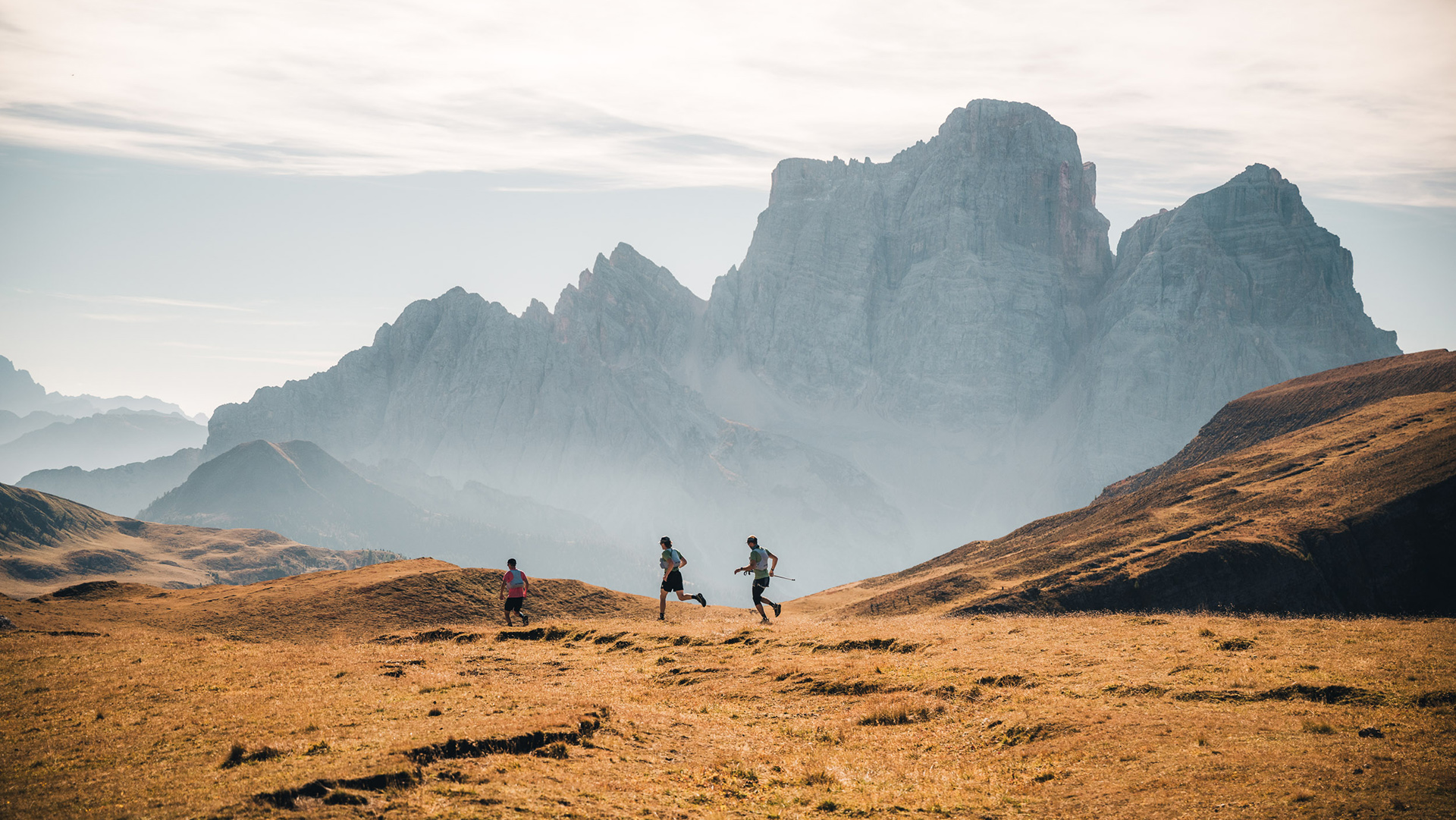
“It’s too beautiful to be true,” I thought to myself as we drove past flawless, luscious green pastures grazed by cows, picture-perfect huts, small, well-kept churches and the most stunning mountain ranges I’ve seen in my entire life, on the way from Munich Airport to San Cassiano where the rest of the team was waiting for us. I was itching to go out and try my legs at altitude, but I also knew I wouldn’t be able to do any running until the day after. So I stayed put and stared out of the window of the Mercedes minivan, trying to imprint the view of the Dolomites in my retina forever.
The purpose of the trip was to test the soon-to-be-available SP0088 Adidas Sport Sunglasses (external link) with a unique feature: you can clip prescription glasses into the frame, making them super versatile performance eyewear for people with visual impairments. You get the best of both worlds, as the sunnies are comfortable and light enough to wear all day, and they can also help you see better when the clip-ins are in place. The trip provided an excellent opportunity to test the capabilities and limitations of the SP0088, more of which I’ll share below.
Just driving around in the mountains put me in a much better mood than I was in the morning after having to wake up at 3 am to catch the 6 am flight to Amsterdam and then to Munich. Worse still, my first flight got slightly delayed, so I sprinted around Schiphol Airport to find the gate for my connecting flight, which didn’t help reduce my anxiety levels. Once I sat in my transfer van and first spotted the tall peak of the Zugspitze, I immediately felt relaxed.
The first night went smoothly. I was introduced to the international team of content creators, bloggers and journalists, and we had a rundown of the sunglasses by a representative of Marcolin, the brand designing eyewear for Adidas Sport. Casa Salares, the hotel we stayed at, was the poshest place I’ve ever stayed in, with a huge private balcony overlooking the Dolomites. Sadly, I didn’t get the chance to fully indulge myself in what the room had to offer, as, after dinner, it was time to turn in so I could be ready for the run the day after.
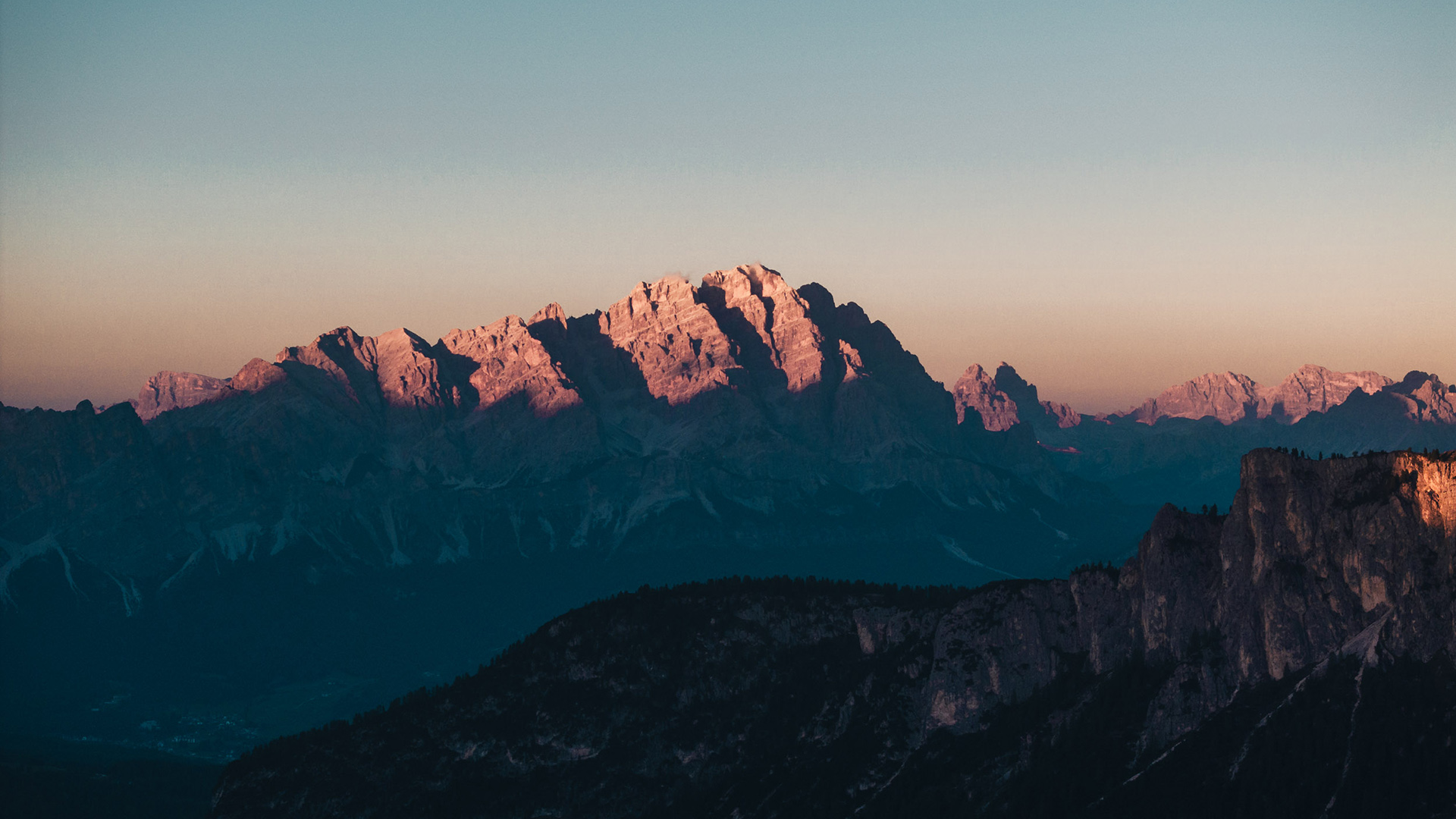
Ethereal distances
After a terrible night’s sleep – nothing to do with the lovely hotel; I never sleep well in hotel rooms – I was downstairs by 7:15 am, waiting for my breakfast. The start of the run was scheduled for 8:15 am, and by then, we had to be packed, dressed and fed, ready for the adventure. Like a good boy, I had some carbs and protein for breakfast and a pot of black coffee, so I was raring to go by the time the whole team was lined up in front of Casa Salares.
After a light jog to Piz Sorega, the cable car that took us up to the starting point of the trail running experience, we were briefed by the superb team of two expert guides from Dolomite Mountains, Loris and Paulo. They explained where we were and pointed out where we were headed in the distance. ‘We’ll have lunch there,’ said Paolo, aiming his hiking stick at Rifugio Lagazuoi, the highest and the most prominent mountain hut in Cortina d'Ampezzo with panoramic views over the Dolomites.
It’s located at 2,752 metres of altitude, and considering we were at around 2,100 metres at the time, my brain couldn’t comprehend the information, so I decided to trust our guides instead of trying to make sense of what I’d just been told. How would we be able to get there by noon? It was already 9 am, and the distance between us and the Rifugio felt like 10 days of intense hiking away.
Get all the latest news, reviews, deals and buying guides on gorgeous tech, home and active products from the T3 experts
We started running, which put my mind at ease. Running is a movement I’m intimately familiar with. It gives me great comfort when I move my legs, which helped me countless times in the past when I was stressed or overwhelmed. I’m not a professional runner and don’t run fast, but I love doing it. No matter how far those peaks looked, I felt confident we’d be able to get there in time.
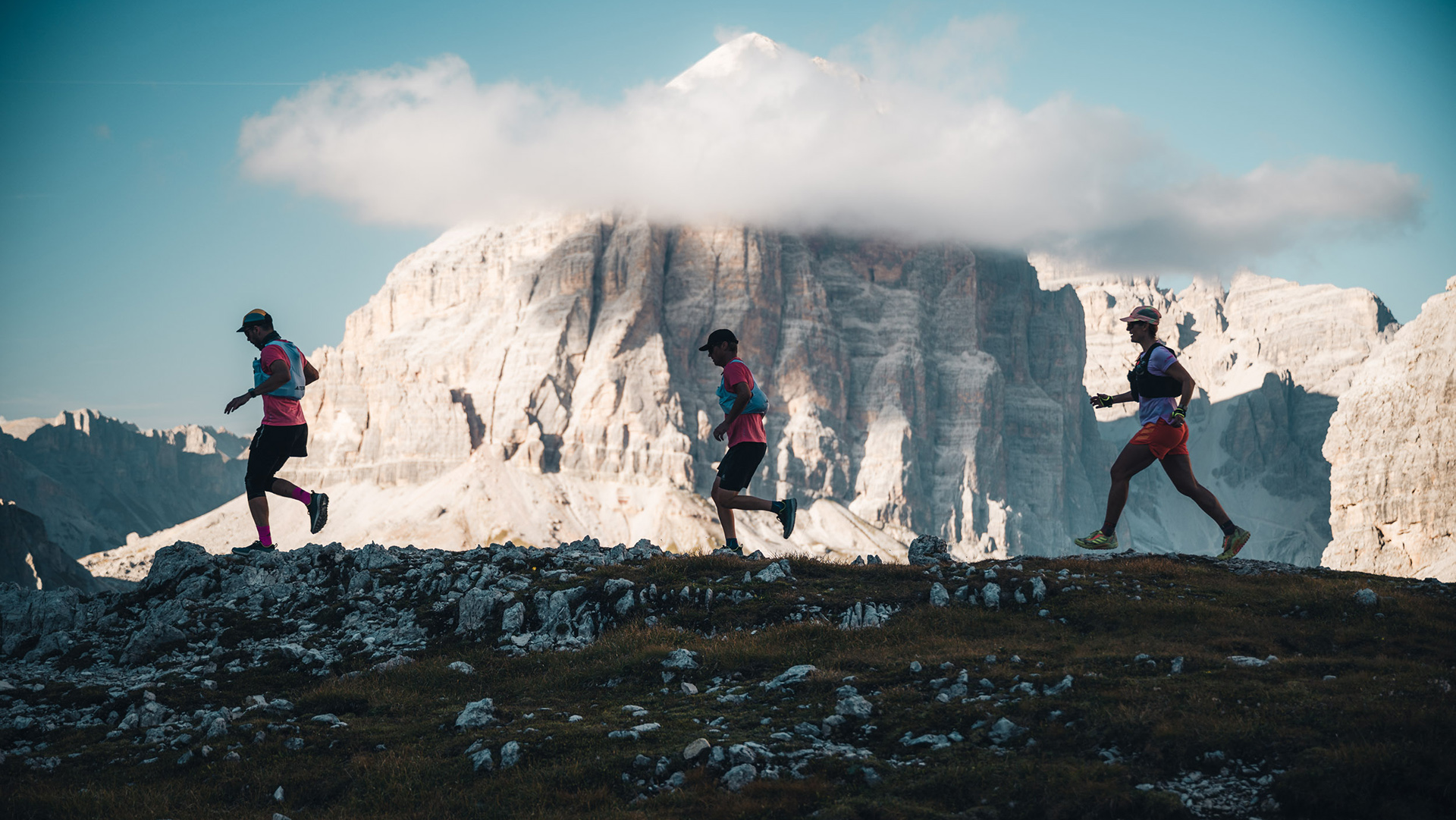
Mountain fever
The Dolomites are something else. Wherever we got to a viewpoint, I thought, 'That's it. This is the most beautiful place I've ever seen in my life'. Half an hour later, you reach another peak, which is twice as stunning as the one before. You do this repeatedly until your brain forgets what the word 'beautiful' means. It's easy to get used to pretty and get lost in it.
One of the best aspects of the trip was that our guides were able to tell us loads about the geography and history of the Dolomites. Most of the Dolomites are made of dolomite rock, a type of limestone with a high percentage of the mineral dolomite. Interestingly, the highest mountain of the Dolomites, the Marmolada, towering over other peaks at 3,342 metres, isn't made of dolomite rock, only limestone.
The Dolomites also have a rich military history. We ran past a number of places where battles took place, such as Col di Lana, or as locals like to call it, 'Col di Sangue' (Blood Mountain), which the Italian and Austro-Hungarian forces fought over in the First World War. We also passed Forte Tre Sassi, an ex-fortress, now a museum on the road to the Passo di Valparola.
Despite its turbulent past, the Dolomites were anything but threatening. It might just have been the mild weather and the sun caressing our skin, but the mountains felt friendly and at peace. Wherever you went and looked, there were no fights or disagreements, only friendly 'Ciao!' exchanged with fellow hikers and cyclists. It felt surreal trying to imagine the reverb of cannons and gunfire in such a peaceful place.
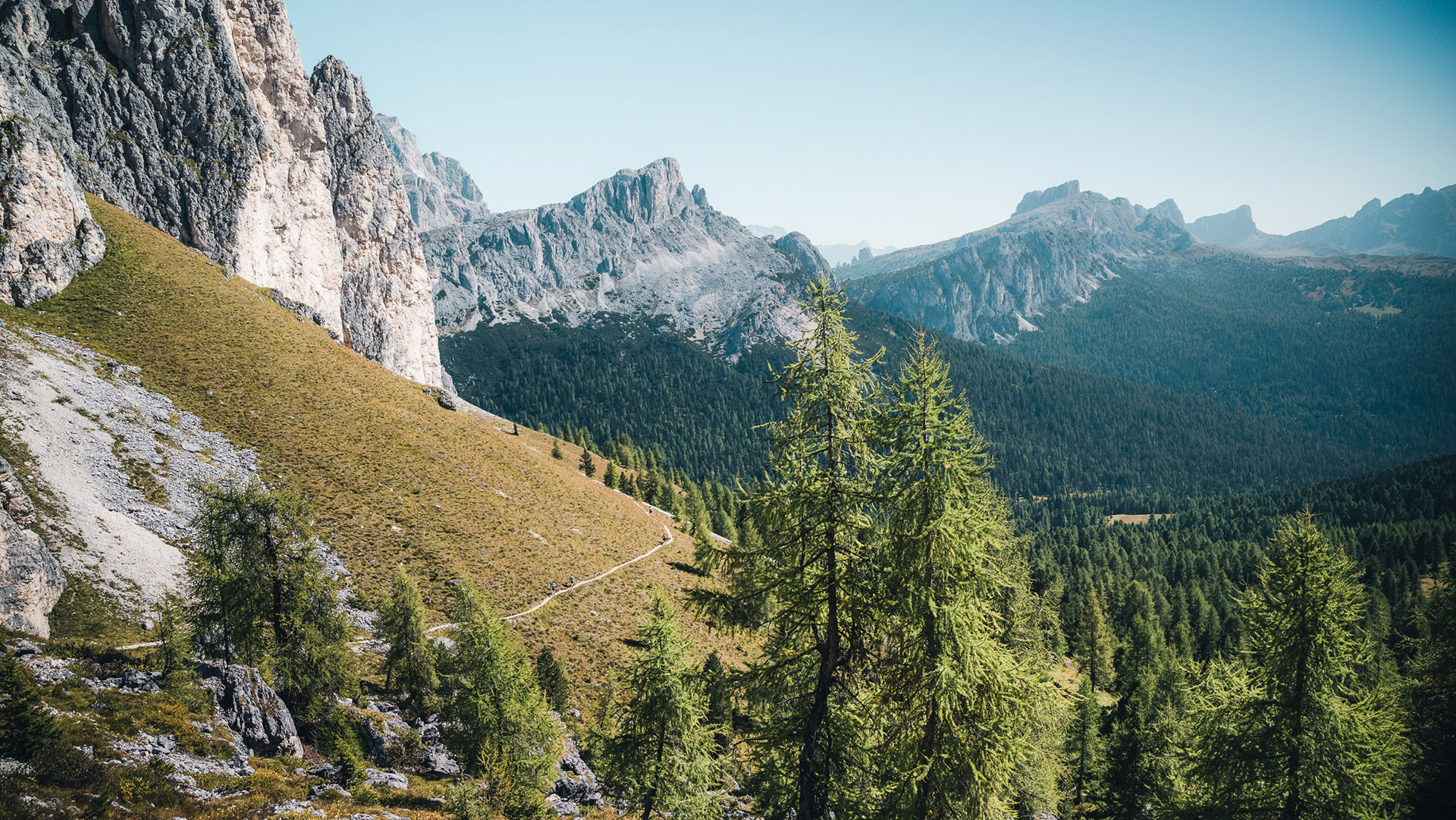
Peaks and troughs
The first day of running felt like a breeze. I never ran at such high altitudes, so I wondered how well my lungs would cope. Thankfully, I didn’t feel like a fish out of the water; quite the opposite. I loved the constant ups and downs of the terrain and the incredible vistas surrounding us. You never get too tired, and you definitely never get bored.
One thing that kept me going was the ever-changing terrain. It went from luscious forests to loose gravel to what looked like the surface of the moon, with large limestone rocks littered around everywhere. Rifugio Lagazuoi, where we had lunch, was the perfect example of this. Looking out over the restaurant terrace, you saw nothing but green forests draped around the mountainsides. Behind the building, the landscape transformed into an almost barren, desert-like terrain, with off-white rocks gleaming palely in the afternoon sun.
Another feature of the experience that reminded me of the constant ups and downs was the duality between taking enough food and drinks and running. It was my first time in the Dolomites, so I wanted to make sure I tried as many different foods as possible. However, after having a massive main meal, a pint of beer, coffee and dessert at Rifugio Lagazuoi, I didn’t have a great time running the first part of the afternoon section.
Someone said on the trip that ultradistance races are basically ‘eating contests with some running in between’, and that’s how I felt when carrying around all that food and drink in my stomach. Truth be told, it was far from impossible to power through the uncomfortable feeling, but by the end of the second day, I couldn’t bear the thought of having any more pasta, so I only ordered a Caprese salad for dinner. You should’ve seen the face of the lady running the Refugio – she wasn’t impressed!
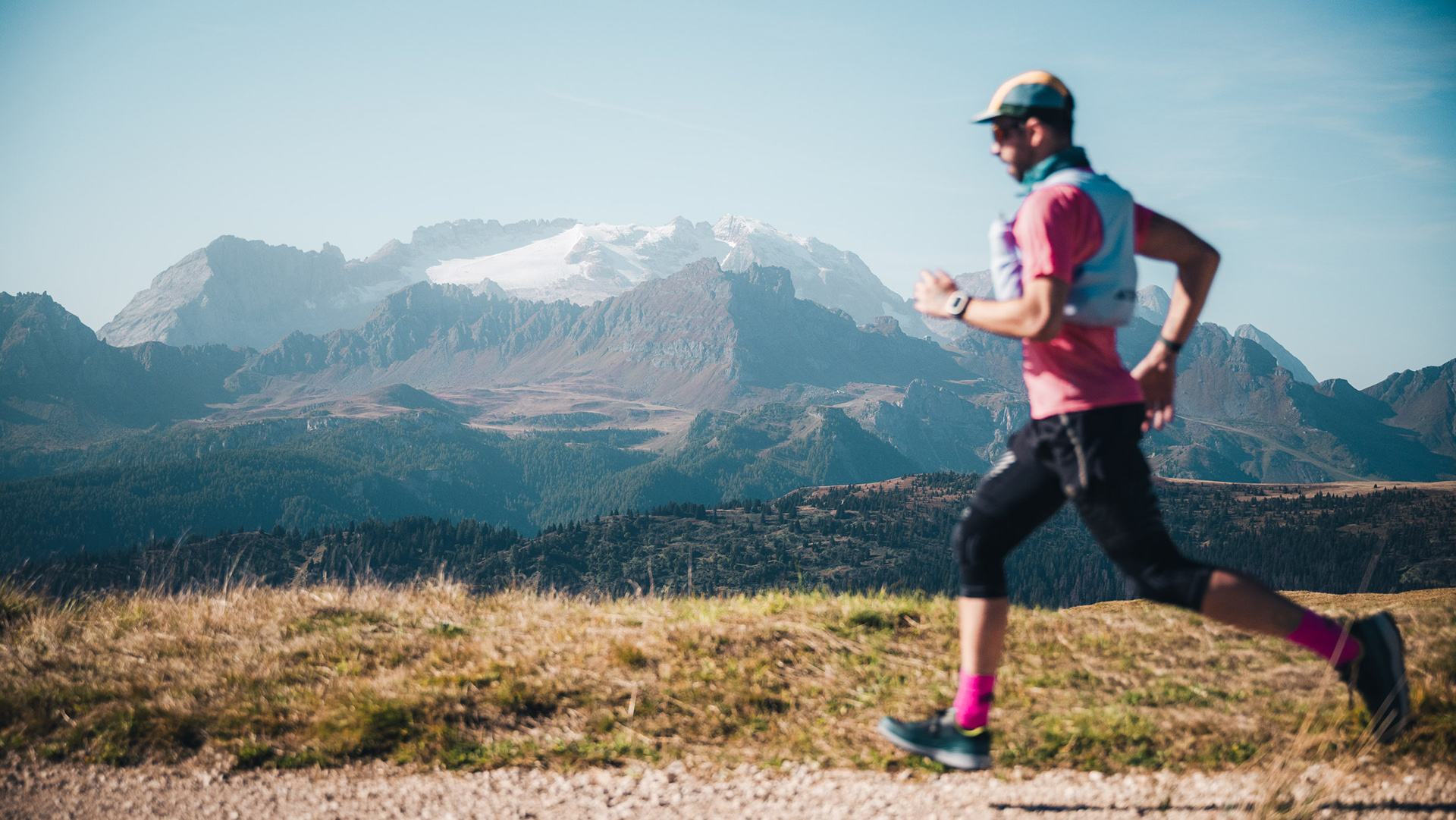
FULL SEND!
By the third day, I was one with the mountains. I put my running gear on, got my bag ready, and was out well before breakfast in the morning. After some warming up, we headed up to Passo Giau, a steep ascent up the side of the mountain. As we climbed, Leonardo, a member of our team and seasoned ultra runner from the Dolomite area, complimented me for having strong legs. Exactly the boost I needed!
Once at the top, we laid our eyes on the Tre Cime di Lavaredo, said to be the most popular and recognisable mountain group in the Dolomites, with their tooth-like shape piercing the sky. By now, distances started to shrink, and my mind began to understand that although some of the peaks look far away, it’s possible to get to them on foot within a reasonable amount of time.
After a short break, we were offered to check out a nearby peak, and most of the team decided to do so. We tracked up and were surprised to find an absolute lack of wind. Looking around, our vision was filled with mountains, alpine lakes and forests. I opened the metal box attached to the cross at the top of the peak and wrote my name and the date in the book found in the box, as custom in the area. I felt pleasantly exhausted, happy and peaceful.
We headed back down to rejoin the smaller group that decided to take the lower path to the next stop and found them resting near a little hut. Me being me, I shouted ‘FULL SEND!’ when we spotted them and started charging towards the group. We exchanged some more laughs and headed further south. On our way down, our guide Paolo spotted some marmots in the grass.
They are cute, larger rodents that make a squeaky noise to warn others of our presence. The only real danger when looking for marmots is missing a step and twisting your ankle, which I nearly did several times. I just about managed to record a short video of a marmot poking its head out of its hole in the ground, looking suspiciously in our direction.
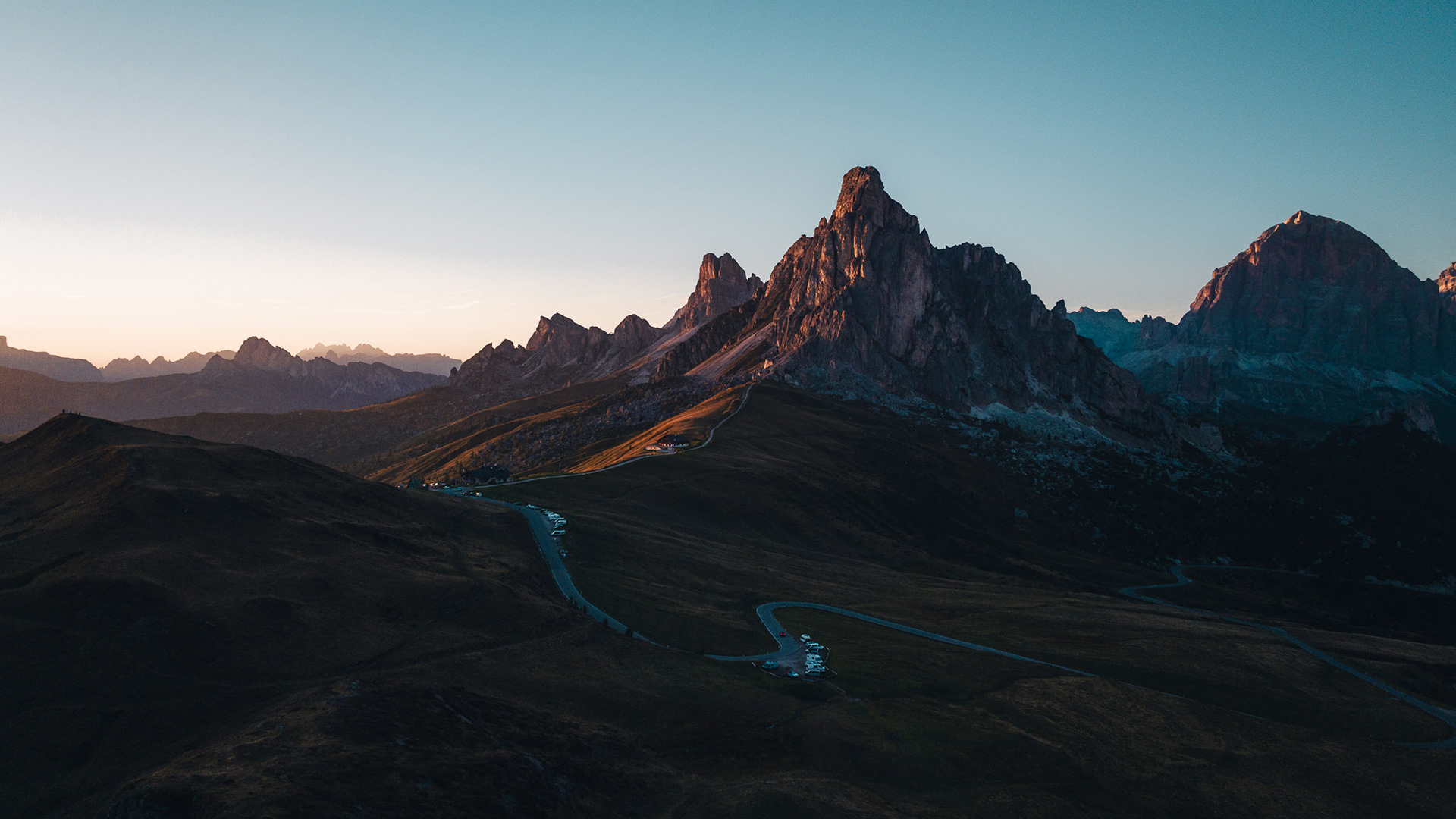
You can be cool, but you’ll never be as cool as a rescue helicopter pilot
Not long after crossing the Field of Marmots, I thought I’d double-check with Loris and Paolo the fauna of the Dolomites. ‘Are there any predators we should know about?’ I asked meekly, but I was reassured there were no dangerous animals in the area.
Wolves have been reintroduced in the Dolomites fairly recently, and their numbers have been growing steadily ever since. These days, there are around 3,000 wolves scattered around the mountains, but it’s almost impossible to spot any during the day.
In fact, the only animals that pose a threat to hikers and runners in the mountains are dogs kept by farmers to keep away the wolves. They can be very aggressive, I was told, and I was glad we didn’t see any farms around us. After all, we were traversing the UNESCO area of the Dolomites, the part more or less untouched by humans.
After crossing a little stream, we encountered two people working on an antenna. There was quite a sizable skip bag full of rubble with them, and we were wondering how they would move it from there, considering there are no roads in the area. The guides had a quick chat with them, and the guys said they were waiting for a helicopter pickup. We didn’t know how long we would have to wait, so after a short while, we decided to get a move on.
One minute later, we heard the sound of the blades echoing in the distance, so we turned around to witness the pickup. The helicopter appeared out of nowhere and drifted about in the air to get in position to pick up the skip bag. Once attached, the pilot tilted the helicopter almost 90 degrees and flew down into the valley.
We were all stunned – even the guys who were to be scooped up by the helicopter were recording the event on their phones – but we were blown away when the pilot came back and picked up the guys without setting the aircraft down on the ground. It was hovering just above the ground, and as soon as the three people jumped in, off it went again. The coolest thing I’ve ever seen in my life.
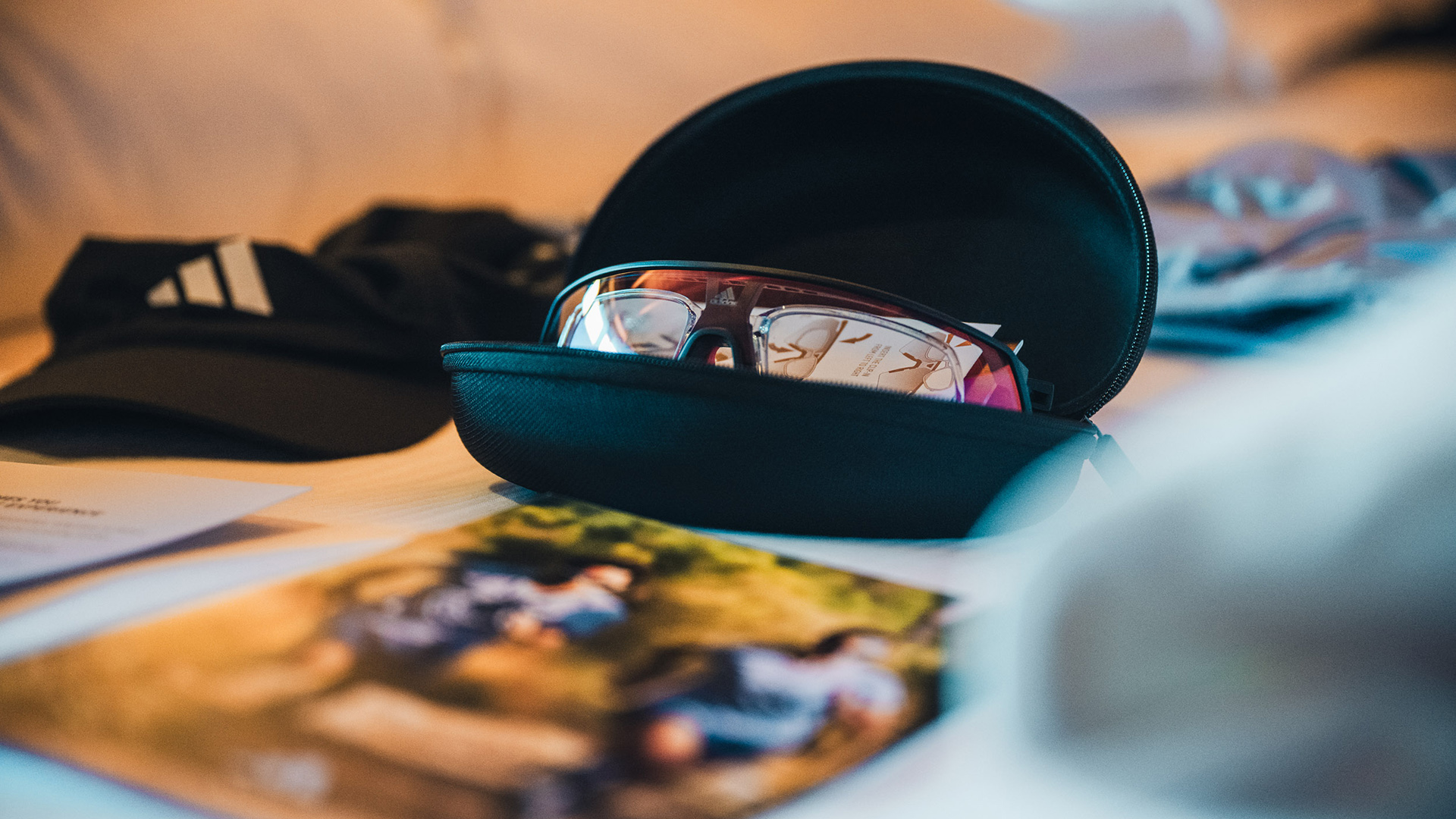
Through the Looking Glass
Like everyone else in the group, I was staring at the daredevil stunts of the helicopter pilot through the SP0088 Adidas Sport Sunglasses. I sort of forgot about it, as the sunnies' lightweight frame and oversized shape made them almost impossible to notice in your vision.
The clip-in bit is smaller, which initially posed a slight challenge. The prescription insert is smaller than the sunglasses, so your brain has to get used to seeing some stuff magnified while objects in the periphery are true to size. This resulted in people miscalculating rocks and some obstacles at first. However, once you figured this out, running with the glasses wasn’t difficult at all.
Another concern of mine is about the longevity of the frame. The sunglasses are super lightweight and have a thin plastic frame, which is good, but I wonder if it would stand the test of time. Performance eyewear should be able to withstand strenuous exercising, and I’m yet to see how the glasses perform over longer periods of time. My initial thoughts are good, though.
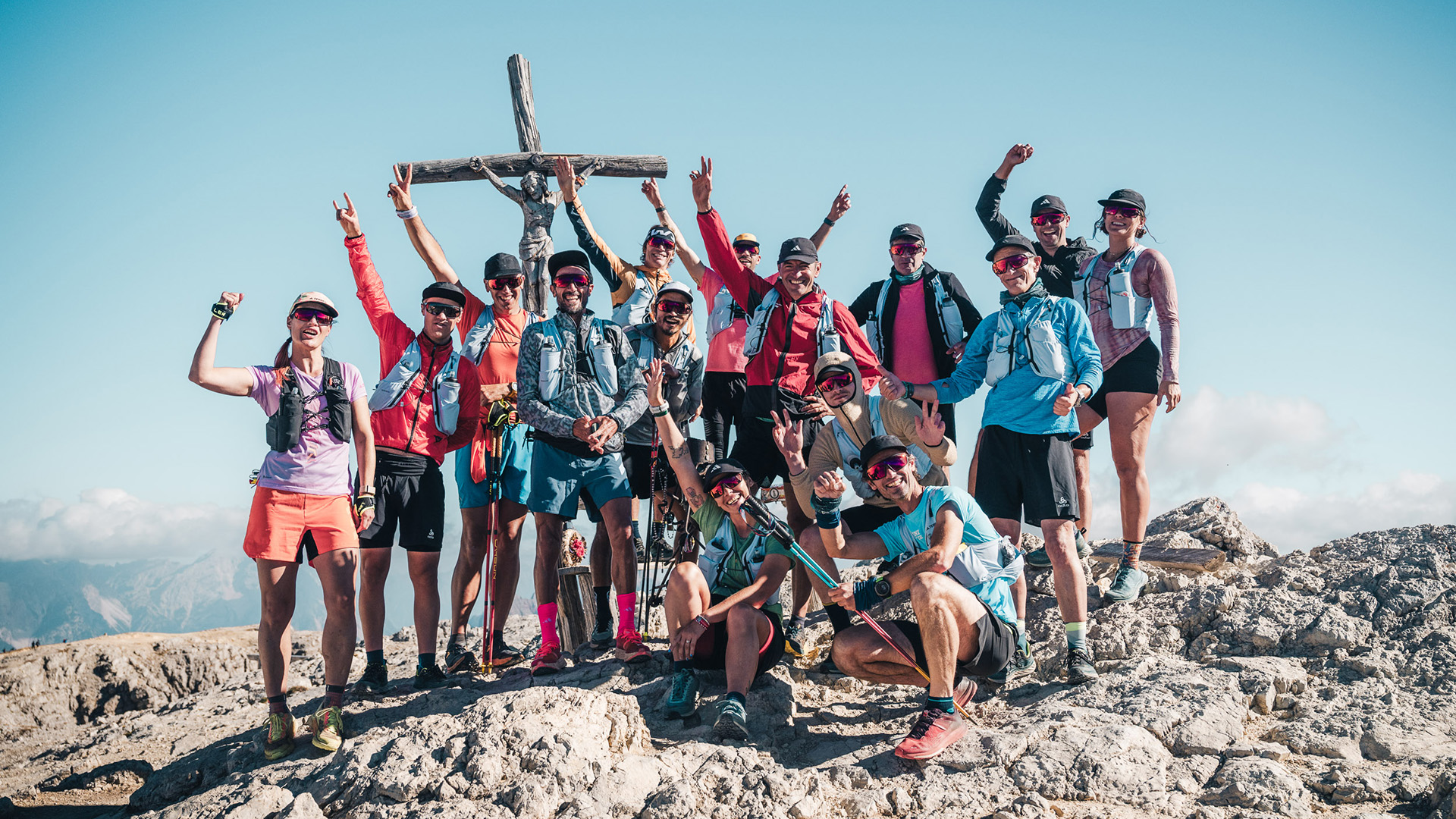
Many laughs were had
After lunch, we headed to the last stop, Rifugio Staulanza, set at the foot of a trail leading up to Monte Crot. It was a short run (around 3k), but the terrain was trickier with wet stones and hidden dips. Once at Staulanza, we were offered a chance to stay or head up to Monte Crot, and needless to say, I decided to do some more hiking/running. The sun was beating down on us, and the ascent was pretty gruelling, but it felt nice to climb up and have one last look around the Dolomites. We cheered, hugged, and congratulated each other; we even took photos with our guides to commemorate the past two days.
The descent back down to Rifugio Staulanza was almost transcendental. In the last section, just before we hit the Refugio, everyone got into the zone and ran at full speed. The gradient was just right, and everyone was keen on emptying the tank one last time before returning home. It was a magical moment, the 10 of us running in almost complete silence, placing one foot in front of the other in quick succession, existing only in that moment.
Once back, we sampled the excellent Dolomiti lager, showered, and, not long after, assembled for dinner. Although I only knew the people I was with for a couple of days, it felt like we were friends forever. It was hard to say goodbye after we finished because I knew I had to head back to Munich before everyone else. But above all, I was also glad I got to experience it all and would do it again in a heartbeat. Dolomites, you are beautiful!

Matt Kollat is a journalist and content creator who works for T3.com and its magazine counterpart as an Active Editor. His areas of expertise include wearables, drones, fitness equipment, nutrition and outdoor gear. He joined T3 in 2019. His byline appears in several publications, including Techradar and Fit&Well, and more. Matt also collaborated with other content creators (e.g. Garage Gym Reviews) and judged many awards, such as the European Specialist Sports Nutrition Alliance's ESSNawards. When he isn't working out, running or cycling, you'll find him roaming the countryside and trying out new podcasting and content creation equipment.